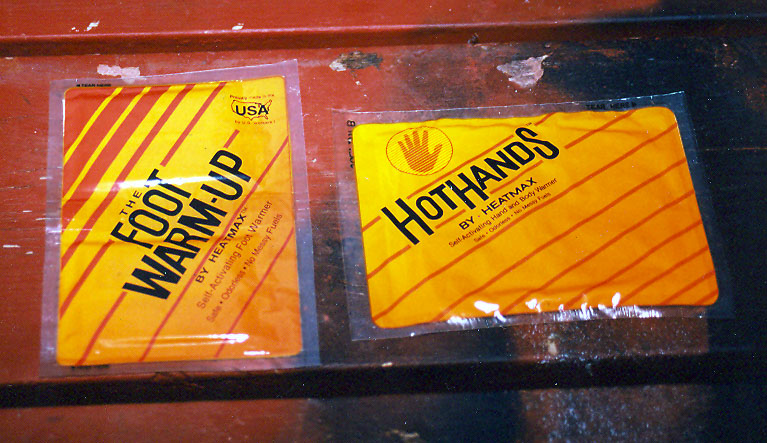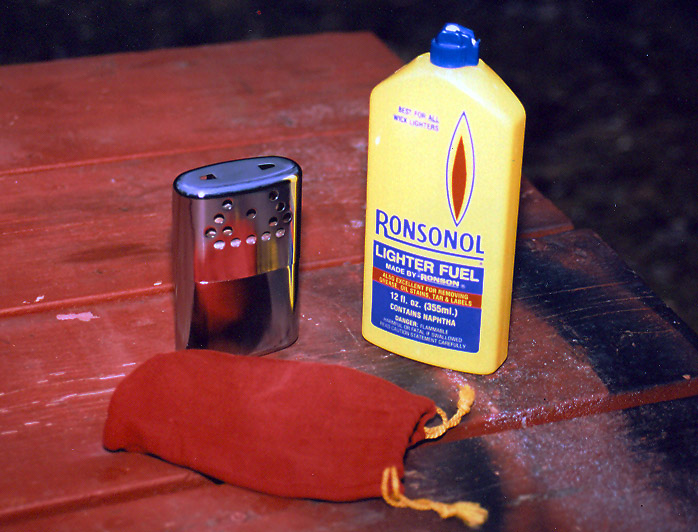Updated 23 January 2011
Keeping Warm at the Telescope
This article will provide my (Joe Roberts) personal recommendations
(based on actual experience) for keeping warm while observing
on cold winter nights.
Winter skies often provide some of the best viewing (as far a
dark, clear skies are concerned) however the cold weather often
deters astronomers from getting out on such nights. Most people
can tolerate a short time in extreme cold, but driving up into
the mountains (in search of dark skies) requires a much longer
duration in the cold since there may be no place of warm refuge
available. I have found that there are a number of ways to stay
very comfortable on even the coldest of nights, even when you have no choice
but to be outside all night. I base these claims on experience
with cold weather observing since 1975. Basically, the requirements
for staying warm fall into two categories: (1) dressing properly
and (2) using "heating" accessories . It will take longer
to prepare for a cold weather observing session. You can
stay comfortably warm all night in the winter if you are willing
to put the extra time in!
Dressing Properly
When dressing for cold winter observing, I recommend the following:
- Thermal underwear, polypropylene type, 2 pair, one larger
than what you normally wear
- Thermal T-shirt, long sleeve type
- Thermal socks, 2 pair
- Sweatshirt, one or two (depending upon temperature)
- Hooded sweatshirt w/ pouch for warming hands (one or two sizes
larger than you normally wear)
- Pants, one or two sizes larger than you normally wear
- face mask
- Insulated boots
- Mittens, the type that open up and allow fingers to access things without the need to remove the mitten
Of critical importance when dressing for cold weather survival:
avoid seams at the point where clothing meets. Make sure
each layer of clothing interleaves and generously overlaps the
previous layer. Make sure shirts, underwear and socks are extra
long (6" more than seems necessary is usually good) for tucking
in. Losing heat in seams (when bending over for example) can
quickly lead to feeling cold! Tip: go to the bathroom BEFORE dressing!
It's not easy to take care of business through 3 to 4 layers of
clothing!
One of the critical areas in keeping warm is the head and neck.
I find that hats alone are not adequate (they leave too big a
seam at the neck and shoulders). A hat (or face mask) combined
with a hooded sweatshirt is the way to go. The hood string should
be tied! The hood eliminates the seam and keeps you much
warmer. On the very coldest nights I wear two hooded sweatshirts
plus the face mask!
Because you will be wearing anywhere from 2 to five layers of
clothing, you will look much fatter and movement will be somewhat
restricted. Agility can be restored (relatively speaking!) by
making the clothing in each layer one size larger than the previous.
Heating Accessories
Despite the availability of very heavily insulated clothing that
is now commonplace, in my experience devices that generate
heat are a necessity for extended observing on cold nights. The
following items are recommended:
- "Foot Warmers" and/or "Hand Warmers",
the chemical type. These devices resemble a large, flat "teabag";
they are kept sealed in plastic and opened when needed. Oxygen
then enters the porous pouch and starts a chemical reaction with
the internal ingredients (some type of charcoal based powdery
substance). These "Hand and Foot Warmers" are available
at most sporting goods or ski shops (Amazon
 carries them too). I find them to work very
well, especially for feet!. They generate a moderate, even
heat that lasts for hours. Place one chemical pack in each of
your boots; use two per boot for extremely cold nights. These
chemical packs put out decent amounts of heat for 4 to 6 hours,
so unless you're planning on staying out all night you won't have
to "reload". Note that there are two varieties... "hand"
warmers and "foot" warmers. The foot warmers appear
to be chemically adjusted to put out good heat with the lesser
amount of available oxygen found at the bottom of a boot. You
can use "foot" warmers for your hands, but they do get
warmer when out in open air! The hand warmer versions are good
for moderately cold nights, but if it's really cold outside,
use a "white gas" hand warmer (described next).
carries them too). I find them to work very
well, especially for feet!. They generate a moderate, even
heat that lasts for hours. Place one chemical pack in each of
your boots; use two per boot for extremely cold nights. These
chemical packs put out decent amounts of heat for 4 to 6 hours,
so unless you're planning on staying out all night you won't have
to "reload". Note that there are two varieties... "hand"
warmers and "foot" warmers. The foot warmers appear
to be chemically adjusted to put out good heat with the lesser
amount of available oxygen found at the bottom of a boot. You
can use "foot" warmers for your hands, but they do get
warmer when out in open air! The hand warmer versions are good
for moderately cold nights, but if it's really cold outside,
use a "white gas" hand warmer (described next).

Chemical Type Hand and Foot Warmers
- "Hand Warmer", white gas type. These devices have been
around for ages... the one I use looks like a big cigarette lighter
(the old fashioned type). The device has a hunk of cotton inside
a metal enclosure which is saturated with white gas fuel. The white gas
vapors rise out of the enclosure and are burned in a wick. These
devices put out a lot more heat than the chemical hand warmers.
One "full tank" of fuel will last you all night (at
least with the unit I have). The unit is placed in a fabric bag,
as direct contact with the skin could result in burns. Some people
have asked me about possible dangers of having a "smoldering
fire" inside your pocket... I have never heard of one of
these devices causing a person to "catch fire". These
units work so well that I sometimes don't use gloves or mittens even on very
cold nights! I keep the warmer in the pouch on my hooded sweatshirt,
and my hands are in there with it when not adjusting the scope.
Clutching the warmer rapidly warms cold hands back up to normal!
On the downside: these white gas warmers can be difficult to light.
Light the unit indoors (or someplace where the air is very still); they must sit
for about five minutes in still air before being used. Lighting
an ice cold warmer is also very difficult. I often light my unit
BEFORE driving off into the mountains, since the unit gives so
many hours of good heat. I have used my warmer since Christmas
1975, and do not know how I would get along without it! You can get them from sporting good stores or Amazon
 .
.

white gas Type Hand Warmer
- Propane Heater: I have only used this device a few times but
it works pretty well for certain applications. The device
is basically a burner (with a heat reflector) that screws onto
the top of a propane cylinder. The unit emits a red glow when
on; it's not real bright, but some observers may find it a nuisance.
Best to aim it away from your eyesight (no problem if you are
observing alone). The unit puts out decent radiated heat, and
is useful for warming accessories (or keeping them warm) on cold
nights. Keep the unit away from the front of the 'scope because
it creates very bad seeing otherwise! As a word of warning, DO
NOT ever use this kind of device in an enclosed area (CO poisoning
and death could result!).
- "Heat Seat": This device is basically a pouch of
some kind of gelatin substance that is heated in a microwave and
then placed into an insulating pouch. It basically is a "thermal
mass". These devices are really intended for sports fans
and hunters (provides a warm seat). This device does work well
as a warm seat, and it also works great for warming your hands.
By slipping cold hands into the pouch you can warm them up in
a hurry. The box the Heat Seat comes in claims that it holds heat
for up to 8 hours, but in practice I find that this is quite optimistic;
2 to 4 hours (depending on the ambient temperature) is what I
consider its useful life. This accessory is a good supplement
to the items described above.
- Hair Dryer: If you have access to 120 VAC power (from a building), a hair dryer can be a great heating device! I use one in my observatory. If I get a little cold I turn it on low and put it inside my jacket. It's also great for quickly warming up cold boots!
Other tips
Below are some other tips and recommendations to help you keep
warm on those cold winter nights:
- When observing in the winter, your feet are in constant contact
with a huge heat sink: the frozen ground! Find or make something
to stand on so that your feet are not in direct contact with the
ground. Use a material that provides some form of insulation!
Even a piece of plywood raised an inch above the ground is a big
help. Old carpet remnants also work well.
- With my telescope, some things must be done by kneeling on the
ground (polar aligning the scope for example). I keep a large
chunk of foam padding (about 2 feet square by 5 inches thick)
for such purposes. Not only does it provide excellent insulation,
it's very comfortable on the knees! This accessory is useful
all year round (keeps the knees dry in damp summertime observing
sessions).
Summary
By dressing properly and using heat generating or retention accessories,
you can stay very warm and comfortable for an entire night even
under very cold (like 0 degrees F) conditions. It will take longer
to dress (and undress), and you will look much fatter and heavier!
If you wear a face mask, you may even begin to look like you come
from another planet. Follow the recommendations on this page and
you will stay warm!
"Back" links, e-mail and Copyright
Use your browser's "back" button, or use links below if you arrived here via some other path:
This page is part of the site Amateur Astronomer's Notebook.
E-mail to Joe
Roberts
Images and HTML text © Copyright 1998, 2011 by Joe Roberts. Please request permission to use photos for purposes other than "personal use".



